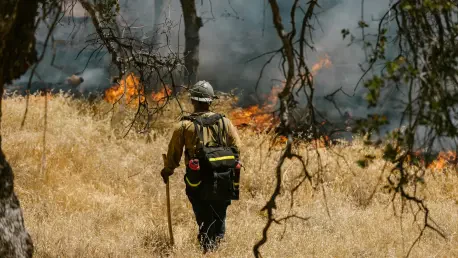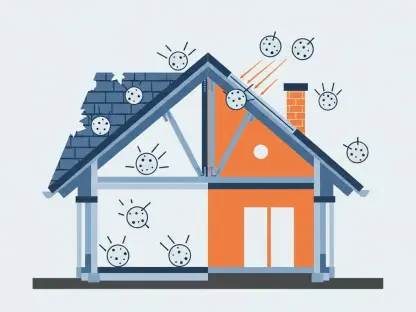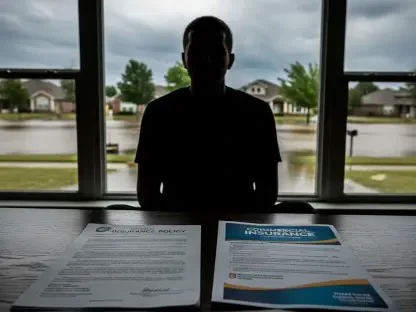In the heart of Hong Kong’s scenic landscape, a devastating wildfire at Pat Sin Leng has recently ignited more than just the rugged terrain—it has set ablaze critical conversations about environmental risks and their far-reaching consequences on property and financial security. This alarming event has exposed the vulnerabilities of a region often considered insulated from such natural disasters, prompting urgent discussions among property owners, insurers, and real estate investors. The incident serves as a wake-up call, highlighting how unpreparedness for wildfires can ripple through financial markets and personal investments. As stakeholders grapple with the aftermath, the focus has shifted to how such disasters could reshape the cost of living and property ownership in one of the world’s most densely populated areas.
Insurance Sector Under Pressure
Rising Premiums and Policy Adjustments
The wildfire that swept through Pat Sin Leng has placed immense strain on Hong Kong’s insurance industry, with insurers now facing the daunting task of reassessing risk models in light of this unexpected disaster. Properties in areas previously deemed low-risk are suddenly under scrutiny, and this shift is likely to result in higher premiums for homeowners and businesses alike. The financial burden could be significant, particularly for those in rural or semi-rural zones near natural landscapes, where fire hazards are now a stark reality. Insurers are compelled to recalibrate their policies to account for these emerging threats, a move that may lead to stricter coverage terms and increased costs. This recalibration is not merely a reaction but a necessary adaptation to a changing environmental landscape, where such events may become more frequent. The challenge lies in balancing affordability for policyholders with the need to maintain profitability in an industry already navigating tight margins. As these adjustments unfold, the broader implications for property owners are becoming clearer, with many bracing for tougher financial decisions ahead.
Impact on Affordability for Homeowners
Beyond the immediate policy shifts, the Pat Sin Leng wildfire has sparked a deeper concern about the affordability of property insurance for Hong Kong residents. As premiums rise to reflect heightened risks, many homeowners may find themselves priced out of adequate coverage, leaving them vulnerable to future disasters. This issue is particularly acute for lower- and middle-income families who already struggle with the high cost of living in the region. The potential for reduced coverage or higher deductibles adds another layer of financial stress, forcing individuals to weigh the cost of protection against other essential expenses. Meanwhile, insurers argue that these adjustments are critical to ensuring the sustainability of their services in the face of growing environmental uncertainties. The tension between protecting clients and managing risk underscores a broader dilemma within the industry, one that could redefine how insurance is perceived and prioritized by the public. This evolving dynamic is likely to influence not just individual budgets but also community resilience as a whole.
Real Estate Market Dynamics
Environmental Risks Reshaping Investment Decisions
The aftermath of the Pat Sin Leng wildfire has introduced a new variable into Hong Kong’s real estate market, with environmental risks now playing a pivotal role in shaping investment decisions. Prospective buyers, once focused primarily on location and price, are increasingly factoring in the potential for natural disasters when evaluating properties. This shift could lead to short-term volatility, as hesitation among investors creates fluctuations in demand, particularly for properties in areas perceived as high-risk. Real estate agents and developers are now tasked with addressing these concerns, often by highlighting mitigation measures or proximity to emergency services. However, until comprehensive risk assessments and protective strategies are widely implemented, some segments of the market may experience a slowdown. This uncertainty poses challenges for a sector already navigating economic pressures, yet it also underscores the importance of transparency and preparedness in maintaining buyer confidence amidst evolving threats.
Pathways to Long-Term Market Stability
Despite the immediate challenges posed by the Pat Sin Leng wildfire, there is potential for Hong Kong’s real estate market to achieve stability through proactive measures and strategic planning. Experts suggest that regulatory frameworks aimed at enhancing property safety could play a crucial role in reassuring investors over time. Infrastructure improvements, such as better firebreaks and early warning systems, are also seen as vital steps toward mitigating risks and protecting property values. Additionally, collaboration between government bodies, developers, and insurers could foster innovative solutions, such as subsidized safety upgrades for vulnerable areas. While these initiatives may take years to fully materialize, they offer a roadmap for balancing growth with the unpredictability of natural disasters. The focus now is on turning this crisis into an opportunity to build a more resilient market, one that prioritizes long-term sustainability over short-term gains. As these efforts progress, the hope is that confidence will return, ensuring that environmental challenges do not permanently derail investment in the region.
Navigating Future Uncertainties
Building Resilience Through Regulation
Looking back, the Pat Sin Leng wildfire served as a critical turning point for Hong Kong, prompting a reevaluation of how environmental risks intersect with financial and property sectors. In response to the disaster, discussions around new regulations gained momentum, with stakeholders advocating for stricter building codes and enhanced safety measures to protect vulnerable areas. These proposed changes aimed to create a buffer against future wildfires, ensuring that both insurers and property owners were better equipped to handle such events. The emphasis on regulation reflected a broader recognition that reactive measures alone were insufficient in an era of increasing environmental unpredictability. By prioritizing proactive policies, authorities sought to lay the groundwork for a more secure future, even as the specifics of these regulations remained under deliberation.
Collaborative Solutions for Sustainable Growth
Reflecting on the aftermath, the wildfire also underscored the importance of collaboration among diverse sectors to address the challenges it exposed. Insurers, real estate professionals, and government officials began exploring joint initiatives to fund infrastructure upgrades and public awareness campaigns about wildfire prevention. These partnerships were seen as essential for distributing the financial and logistical burdens of adaptation, ensuring that no single group bore the full weight of recovery. Moreover, engaging communities through education and resource allocation emerged as a key strategy for fostering resilience at the grassroots level. The collective response highlighted a shared commitment to safeguarding Hong Kong’s future, with actionable steps like improved emergency planning and risk mitigation programs taking shape. These efforts pointed toward a sustainable path forward, offering practical solutions to navigate the uncertainties of a changing environment while protecting both lives and investments.









